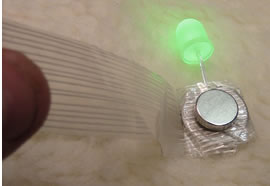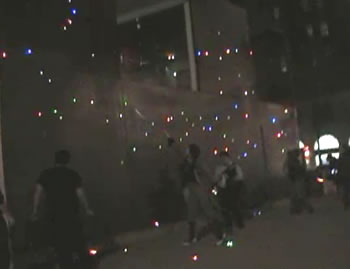Science Fiction
Dictionary
A B C D E F G H I J K L M N O P Q R S T U V W X Y Z
IR Chemical Communication Graffiti Tags Wanted By DARPA

The Chemical Communications (ChemComm) program objective is to encode and transmit information in a rapid and covert manner. DARPA is asking for proposals for a PDA-sized device that will quickly print out coded tags, with a specific message, for placement in strategic locations in different environments, to be read by unmanned aerial vehicles (UAVs) or planes. The tags will be used to mark locations of interest, identify friendly forces embedded or trapped in combatant zones, and in various surveillance and reconnaissance missions.
Specifically, DARPA wants these features:
DARPA suggests that oscillating chemical systems could form time-repetitive sequences of characters, or that a chemical shutter could generate a modulated optical signal from one static chemical function. However, any innovative approach that meets the goals of the proposal will be considered.
DARPA envisions the disposable transmitter having a "weight and form factor ranging from a sheet of paper to a piece of string, possibly with an adhesive backing for deployment on all surfaces."
The "substrate" or transmitter is thus a graffiti tag, but not like the ones that you see in alleys and on trains. DARPA prefers that the message be transmitted invisibly, using near infrared (NIR) or short-wave infrared (SWIR).
Science fiction writers could make several suggestions here. For one thing, you will want a strongly adhesive backing that would resist any efforts to remove it. In other words, a smart tag as described in All Tomorrow's Parties, a 1999 novel by William Gibson:
Smart tags were created in response to smart material, a special finish that would "eat" graffiti, which would be the expected enemy response to DARPA ChemComm tags:
DARPA also does not specify what the transmitter, ideally a "sheet of paper," should look like. If it covers a surface that is visible to a UAV, a person might also be able to see it. The sheet should therefore look like it belonged there.
One approach would be to disguise it as anti-American graffiti or posters of local political figures. Graffiti in Baghdad was once punishable by death; now it is commonplace.
However, in villages, Iraqi army soldiers and Multinational Division–Baghdad patrols often paint over graffiti whenever they see it. You don't want your own troops painting over your expensive DARPA-produced ChemComm tags.
Someone had once come up with a smart tag, a sort of decal they'd somehow adhered to the [smart] wall, although [they] had not been able to figure out how they'd done it without being seen. Maybe they'd shot it from a distance.
(Read more about the smart tag)
The gang kids would come and tag it; twenty minutes later these flat, dark, vaguely crab-like patches of dark blue would come gliding out around the corner… They seemed to be embedded, a few millimeters down into the surface, which was a sort of non-glossy gel-coat affair, but able to move around under there.
(Read more about smart material)

(Child paints over graffiti)
The other obvious thing to do is to make the tags invisible. They could be made of clear, non-reflective plastic, or the tags could actually be invisible. See Invisibility Cloaks Seen As Possible With Metamaterials and Invisibility Possible With Superlenses for details on progress in this area.
As with any DARPA proposal, the technologies are years away from being usable. However, if DARPA wants to get started right away with a quick, homebrew technology that already works, they should try making some LED Throwies.

(LED Throwie)
An LED Throwie is basically a light-emitting diode taped to a small circular battery, in turn taped to a small circular magnet. Change the standard instructions by using an infrared LED, then add a little IC that accepts your 60 character code and transmits it in the DARPA-approved manner, and presto! your chemical communications gear is ready and you can start tagging.

(LED Throwie enthusiasts tagging a building)
I also wonder whether or not DARPA is thinking far enough out of the box on this one. For example, why not have this robot painter actually create a composition on the roof or the wall, using chemical paints that provide the necessary signalling features?
Read more about the DARPA Chemical Communications (ChemComm) program. Take a look at these instructions for making an LED Throwie, as well as a movie demonstrating LED Throwie tossing technique. See science-fictional technologies come to life in this DARPA project list.
Scroll down for more stories in the same category. (Story submitted 3/29/2007)
Follow this kind of news @Technovelgy.| Email | RSS | Blog It | Stumble | del.icio.us | Digg | Reddit |
Would
you like to contribute a story tip?
It's easy:
Get the URL of the story, and the related sf author, and add
it here.
Comment/Join discussion ( 2 )
Related News Stories - (" Surveillance ")
LingYuan Vehicle Roof Drones Now Available, ala Blade Runner 2049
Accompanied by a small selection of similar ideas from science fiction.
Chameleon Personalized Privacy Protection Mask
'...the Virtual Epiphantic Identity Lustre.' - Neal Stephenson, 2019.
Spherical Police Robot Rolls In China
'Rand could effectively be in several places at once...' - Niven and Pournelle, 1981.
Vietnam To Have Full Biometric Transparency
'inscriptions too small to be seen with the naked eye; microscopic data...' - Eric Frank Russell, 1939.
Technovelgy (that's tech-novel-gee!) is devoted to the creative science inventions and ideas of sf authors. Look for the Invention Category that interests you, the Glossary, the Invention Timeline, or see what's New.
Science Fiction
Timeline
1600-1899
1900-1939
1940's 1950's
1960's 1970's
1980's 1990's
2000's 2010's
Current News
iPhone Air Fulfils Jobs' Promise From 2007 - A Giant Screen!
'... oblongs were all over the floor and surfaces.'
ChatGPT Now Participates in Group Chats
'...the city was their laboratory in human psychology.'
iPhone Pocket All Sold Out!
'A long, strong, slender net...'
Did The Yautja Have These First?
What a marvel of ingenuity the little device was!
Jetson ONE Air Races Begin, Can Air Polo Be Far Behind?
'If you're one of those rarities who haven't attended a rocket-polo "carnage", let me tell you it's a colorful affair.'
Will Space Stations Have Large Interior Spaces Again?
'They filed clumsily into the battleroom, like children in a swimming pool for the first time, clinging to the handholds along the side.'
Mornine Sales Robot
'Robot-salesmen were everywhere, gesturing...'
Bipedal Robot Floats Gently While Walking
'a walking balloon proceeded with long strides of its aluminum legs...'
Musk Idea Of Cars Talking To Each Other Predicted 70 Years Ago
'My cars talk to one another.'
Elegant Bivouac Shelter Produces Water And Electricity
'There was nowhere on the planet where science and technology could not provide one with a comfortable home...'
X-Control Janus-1 A Suitcase Aircraft
'You will notice that it... fits the suitcase nicely.'
'AI Assistants' Are Actually Less Reliable For News
'Most men updated their PIP on New Year's Day...'
YES!! Remote Teleoperated Robots predicted by Technovelgy!
'...a misshapen, many-tentacled thing about twice the size of a man.'
Will Robots Ever Fold Landry?
Where have you gone, Mrs. Robinson?
Will AIs Give Better Results If You're Rude To Them?
'I said, "Listen up, motherf*cker.'
Cybertruck Robotic Arm F10 Drone Launch!
Drone away!
